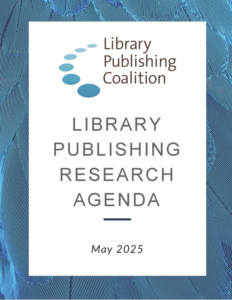 Correction Note
Correction Note
This file was corrected on August 28, 2025, to reflect accurate authorship. No other changes were made to the text of the Research Agenda.
Abstract
This second edition of the Library Publishing Research Agenda builds on the foundation laid by the original 2020 publication, continuing to explore critical areas where research is needed to inform and strengthen practice in the field of library publishing. It offers updated and expanded exploratory overviews of six key topics (assessment, labor, accessibility, non-traditional research outputs, peer review, and partnerships), each including a contextual summary, refreshed or newly proposed research questions, and updated resources for further reading. This edition reflects new developments in the field and ongoing conversations within the community. It is intended to support current and future researchers, practitioners, and stakeholders committed to advancing knowledge and practice in library publishing. The Research Agenda was developed by LPC’s Research Committee with input from the LPC community.
Citation
Library Publishing Coalition Research Committee. (2025) Library Publishing Research Agenda (2nd ed.). Atlanta, GA: Educopia Institute. https://doi.org/10.5703/1288284317889
Authors
Created by the Library Publishing Coalition Research Committee: Talea Anderson, Karen Bjork, Leigh-Ann Butler, Nina Collins, Perry Collins, Matthew Goldberg, Jonathan Grunert, Matt Hunter, Michelle LaLonde, John Martin, Shawn Martin, John Morgenstern, Talia Perry, Christopher Popovich, Liz Scarpelli, Janet Swatscheno, Willa Tavernier, Dan Tracy, Michelle Wilson, and Mai Yamamoto
Production
Maggie Rosenau (design and copyediting), Library Publishing Coalition
Copyright
Library Publishing Coalition 2025. Licensed for reuse under a Creative Commons Attribution 4.0 International (CC BY 4.0) license.
Other formats
This document can also be downloaded as a PDF.
Contact
Email contact@librarypublishing.org to give feedback.
Learn more
The Library Publishing Coalition provides a wide variety of free resources for professional development. Learn more at Library Publishing website.
Table of Contents
Introduction
Assessment
Labor
Accessibility
Non-Traditional Research Outputs
Peer Review
Partnerships
Introduction
Each section identifies a topic of interest, research questions we see as pivotal to advancing the field, and a curated selection of resources for those beginning their inquiries. This document, originally published in 2020, is intended as a foundational guide, recognizing that it is neither comprehensive nor static. While it focuses on key areas, many important topics require further exploration, including resource allocation, sustainability, scalability, and preservation. The topics addressed in this document are Assessment, Labor, Accessibility, Non-Traditional Research Outputs, Peer Review, and Partnerships.
Library publishing remains a relatively new and evolving field, with ample opportunities for research and innovation.1 This document is intended as a foundational guide, recognizing that it is neither comprehensive nor static. While it focuses on key areas, many important topics require further exploration, including resource allocation, sustainability, scalability, and preservation. Our emphasis on DEI is woven throughout these topics, underscoring its centrality to every aspect of library publishing.
Our aspiration is for this agenda to be a living document—one that evolves in response to emerging challenges, opportunities, and priorities in the field. By updating this research agenda in 2023–2024, we aim to provide a more inclusive, current, and actionable roadmap for advancing library publishing research and practice. We invite ongoing collaboration and feedback to ensure it remains a dynamic and inclusive guide for the field.
1 As a starting point, researchers may wish to consult the LPC’s library publishing bibliography, available at https://www.zotero.org/groups/1592237/lpc_bibliography/.